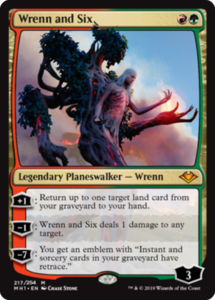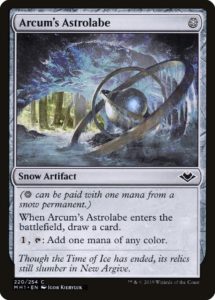Over the last few weeks in Magic we have witnessed a slew tournaments across multiple formats. The steady flow of high-level competition has been exciting. It’s even more exciting that we’ve had multiple new sets infuse new life across Constructed formats. Core Set 2020, Modern Horizons, and even War of the Spark still feel new and less-than-fully explored.
Normally you’d think this would be the best thing ever. A buzz of activity across Constructed formats should be great. But I’m not sure the current metagames are healthy. We might be overdoing it a little bit. So, this week I will go through each format and tell you what’s wrong with each one.
Standard
People seem to enjoy Standard right now. While I can see where they are coming from, I am not a fan. Standard is supposed to be the most interactive Constructed format, compared to Modern or Legacy. This is the format where you can battle your opponents fairly, where the cards you draw matters but what you do with them matters more.
Let’s look back to when War of the Spark released. At that time, Standard was quite interactive. Decks like Jeskai Walkers, Grixis, and Hero of Precinct One variants offered plenty of interaction alongside proactive paths to victory. Nexus of Fate decks were around but not dominant.
Now jump forward to current Standard. We have Feather, Jund Dinos, Nexus, Hero variants, and Scapeshift defining the metagame. Out of those, only the Hero decks offer much interaction. Decks like Nexus and Scapeshift do their thing until they win without worrying about your strategy. Both archetypes are similar to Tron in Modern—big mana that goes over the top with minimal interaction.
On the other end of the spectrum, we have the two premier aggressive decks: Jund Dinos and Feather. Their main decks have at most four cards that interact with what the opponent is doing. Games don’t last very long and can be over as fast as turn four. Both these decks remind me of Modern Izzet Phoenix: some interaction but mostly they are killing you with their efficient creatures.
Midrange decks still exist thanks to Hero of Precinct One, but just barely. The Standard metagame has polarized toward the faster and most over-the-top decks, much like Modern—not exactly what a healthy metagame should be emulating right now. Standard needs to tone it down a few notches. Hopefully it comes after rotation.
Modern
Do I really need to say what is the issue here? Hogaak, the Arisen Necropolis is completely destroying the Modern metagame right now. Even after Bridge from Below was banned, Hogaak decks were still by far the most played at Mythic Championship IV Barcelona.
It is easy to point fingers at individual cards—looking at you, Faithless Looting. But what about this brilliant Tweet from Matt Nass:
Can we all agree that as the most played card in the last mc leyline of the void should be banned? It’s been too good for too long.
— Matthew Nass (@MatthewLNass) August 1, 2019
How broken does Modern have to become to make Leyline of the Void a maindeck card? We were already used to people playing Surgical Extraction in their maindecks, but Leylines are a whole new level of warped.
The next two best decks are Tron and Grixis Urza—two extremely powerful long-game strategies. For other decks, it’s really hard to keep up with that power level. Among “midrange” decks in Modern, Jund is close to being good enough. But the deck doesn’t have eighteen power on turn two or a seven-mana planeswalker on turn three.
There really isn’t any hope for Modern until Hogaak is gone, one way or another.
Legacy
Maybe Legacy is not in such a bad state. Maybe it takes longer to warp the ancient format’s metagame. I think Legacy these days falls more on the unhealthier side than not.
Supplemental sets that don’t go through Standard have a bit of history in Legacy. Think of Conspiracy and Commander products—cards like Palace Jailer and True-Name Nemesis. Those were the big ones.
What now? Modern Horizons may be marketed as supplying new cards for Modern, but it does a little bit more than that. Two cards from the new set have started to exert powerful forces over the Legacy metagame: Wrenn and Six and Arcum’s Astrolabe.

Wrenn and Six is basically the planeswalker version Deathrite Shaman. It enables greedy manabases with its +1 ability while dominating decks like Death and Taxes with its -1 ability. These three- and four-color decks used to be punished by Wasteland, but Wrenn and Six help you continually replay your lands from the graveyard. That’s on a card that also pings for damage? This deck is not such a “pile” anymore.

On a similar note, Arcum’s Astrolabe has come down with force in Legacy. Four-Color Snow Control decks play tons of snow-covered basic lands, which turn on the one-mana cantripping mana fixer. You may have heard that Astrolabe has completely upended the Pauper metagame. Well, Legacy is Pauper for rich people, right?
Now why are these two new cards bad for Legacy? Four-color decks used to be vulnerable to cards like Wasteland and Blood Moon. Wrenn and Six conveniently costs red mana and recurs destroyed lands. Arcum’s Astrolabe turns a snow basics into Reflecting Pools that are impervious to mooning. Suddenly, a big drawback of greedy good-stuff decks feels easier to overcome. That is not healthy for any metagame.
These are my Constructed hot takes. Let me know how you feel! Do you agree or disagree?
Zack is a SCG grinder with one ultimate goal: getting to the Players Championship. Based out of NYC, you can find him in other cities every weekend trying to hit that goal. When he isn’t traveling he streams. Follow his journey on Twitter!

